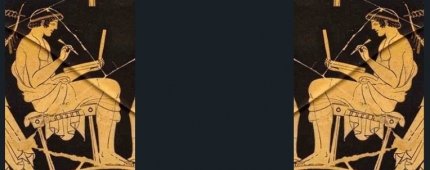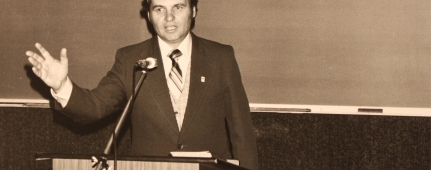Book Review: Craig Blomberg’s Can We Still Believe the Bible?
(Brazos Press, 2014, 287 pages)
Joseph M. Holden, PhD
The following reflections offer comments on some ideas put forth by Can We Still Believe the Bible? (hereafter CWSBB, with all simple page numbers referring to this work), authored by Dr. Craig Blomberg, Distinguished Professor of New Testament at Denver Seminary. Because our central aim is to discuss the various points presented in the work relating to inerrancy, these reflections do not offer an exhaustive evaluation of all points of theological and methodological agreement or disagreement. In addition, we intend to critically review Dr. Blomberg’s ideas, not assail his motives or personal character as a brother in Christ. Thus, the comments will center on various statements, points, logic, and approaches offered in CWSBB as they relate to the doctrine of inerrancy and to the documents of the International Council on Biblical Inerrancy (ICBI). Indeed, the ICBI documents are cited with approval throughout the book (273, n20) and have been adopted by the Evangelical Theological Society (ETS, 2006) as a guide to understanding the meaning of inerrancy; ironically, however, this definition seems to be at odds with some of the content of CWSBB.
I enjoyed reading the many relevant topics discussed in the book, finding myself in agreement with most of its contents, including the section on Bart Ehrman and variants, its strong stand on crucial bibliological topics such as the canon and textual transmission, as well as Blomberg’s general support for the historical reliability of the Old and New Testaments. However, my comments are offered to those who value the traditional understanding of the inerrancy of Scriptures as well as to those interested in maintaining the authoritative nature of the doctrines that flow from them. They are also offered to a broader audience: namely, any Christian who is interested in the effects that a change in this traditional understanding of inerrancy and its undergirding of authoritative doctrines may have upon the evangelical church at large and on its future.
Blomberg is no stranger to controversial views. These include, but are not limited to his ardent support of the use of genre criticism to dehistoricize portions of the Gospels by Michael Licona (using Greco-Roman bios) and by Robert Gundry (using Midrash), as well as his own expressed doubts of the historicity of Jesus’ command about retrieving the coin from the fish’s mouth (263, n113; Mt. 17:27); he considers the passage a metaphorical statement without a basis for its historical fulfillment (JETS 27/4, Dec/84, 433-38). In addition, Blomberg has drawn criticism for his alleged doctrinal compromises with his Mormon coauthor in How Wide the Divide? A Mormon and Evangelical in Conversation (1997).
Blomberg’s latest work is no exception. Evangelicals ought to be concerned that CWSBB identifies his acceptance and application of what some have called the “new historiography” or Licona’s brand of genre criticism (see Licona, Resurrection of Jesus: A New Historiographical Approach, IVP, 2010). Licona describes the “new historiography” thus:
The Gospels belong to the genre of Greco-Roman Biography (bios)….Bioi [pl.] offered the ancient biographer great flexibility for rearranging material and inventing speeches…and often include legend. (Licona, RJ, 34)
In addition, Licona writes, “Because bios was a flexible genre, it is often difficult to determine where history ends and legend begins” (Licona, RJ, 34). Genre criticism has brought grave consequences: Licona has denied a host of historical passages in the Gospels, including but not limited to the resurrection of the saints in Matthew 27:51-54 and the appearance of the angels at Jesus’ tomb because they may reflect “poetic” elements or even “legend” (see RJ, 185-86, 527-28; 548; 552-53).
Even though Licona has had to leave several evangelical institutions as a result of his genre-critical assertions, Blomberg’s open and vocal support for this alien approach to the biblical text has aligned him with those who either deny or cannot affirm the historical veracity of straightforward narrative passages in the Gospels. Blomberg asserts,
Simply because a work appears in narrative form does not automatically make it historical or biographical in genre. History and biography themselves appear in many different forms, and fiction can appear identical to history in form. Other contextual and extratextual indicators must be consulted as well, including comparisons with noncanonical literature of similar form, in order to determine the kinds of narratives we are reading. Occasionally, what has seemed to many throughout the centuries to reflect straightforward history can now be seen to represent a different genre….Yet once again, unfortunately, a handful of ultraconservatives criticize all such scholarship, thinking they are doing a service to the gospel instead of the disservice they actually render (11).
This new trend among many NT evangelical scholars seeks to use extrabiblical genre (e.g., as we have seen from Licona and supported by Blomberg [11, 164], the Greco-Roman bios in the tradition of Virgil, Plutarch, et al.) to determine the meaning of the biblical text. In particular, the trend promotes the use and application of extrabiblical literature that is discovered to be of similar genre as the Gospels to dehistoricize certain narrative biblical passages that present themselves as straightforward historical fact.
According to Blomberg et al., because of these extrabiblical genres’ similarity with the Gospel genre, the customary license (i.e., flexibility to include legend, fiction, and invent speeches) and form associated with these extrabiblical authors were most likely employed to write certain portions of the biblical text. It is argued that these extrabiblical texts help inform us which biblical narrative passages are genuine history and which are merely literary effects (i.e., fiction, apocalyptic, poetic, legend, embellishment, etc.) in the “form” of history. Among many other problems, this approach offers the interpreter a confusing dilemma to sort out since, as Blomberg says, “Fiction may appear identical to history in form” (11).
Apparently, Blomberg seeks to free himself, and by extension free modern evangelicalism, from the tenets of “extreme” view of inerrancy as traditionally defined (10). He seeks to “nuance” and “[re-]define” inerrancy because of the “unprecedented” understanding of biblical cultures NT scholars possess today (10). Why is this nuancing and redefining necessary? According to Blomberg, it is because modern evangelicals are now questioning the doctrine of inerrancy (e.g., Kenton Sparks, Peter Enns, Carlos Bovell, Christian Smith). For Blomberg, the traditional position of full inerrancy (that does not recognize that biblical authors employ fiction and error) is no longer defensible. Sadly, according to Blomberg, these “extremely conservative Christians” who insist on holding to their more “anachronistic” concept of inerrancy and censuring those who seek to introduce their new understandings of the doctrine (10) hinder his genre-critical efforts.
Whatever the motivations may be to redefine and nuance the doctrine of inerrancy, a fair question would be, to what degree? If I proposed to nuance and offer a new definition to the doctrine of the Trinity or the incarnation of Christ, how much latitude would there truly be for such “nuancing”? I’m afraid Blomberg and company are slow to recognize and understand that the inerrancy of Scripture is the fundamental of the fundamentals of Christian doctrine and that the nature of truth is a narrow road; propositions are either true or false by their correspondence to reality, which is not among the tertiary issues that invite intramural debate (e.g., the gifts of the Spirit or the length of the “days” of creation in Genesis 1). Admittedly, inerrancy is not a salvific doctrine that emerges from Scripture, though it is deduced logically from an inductive survey of the whole of Scripture attesting to the facts that 1) God cannot err (Jn. 16:13; Tit 1:2; Heb. 6:18) and 2) the Bible is the Word of God (Jn. 17:17; 2 Tim. 3:16). Only one conclusion (deduction) emerges from this logic: the Bible cannot err (inerrancy).
To avoid this conclusion, one must show one of the two foregoing premises to be false. To which of these premises does Blomberg object? The same kinds of deductions are gathered from Scripture to form conclusions about the doctrine of the Trinity. The inerrant Scriptures are the sole fundamental and essential source from which all our knowledge of these crucial and essential doctrines emerge, and these doctrines are no more authoritative than the God-breathed (theopneustos) text from which they emerge (2 Tim. 3:16; Jn. 10:35). What is more, since biblical doctrines often emerge directly from historical events, as stated in Scripture (Rom. 4:25; 10:9-10), it follows that these doctrines are no more authoritatively secure than the historical truth from which they flow (Jn 3:12).
One thing is clear: there is a shift in paradigm occurring among evangelical NT scholars who seek to introduce critical methodologies into the inerrancy discussion–and sadly, this shift has resulted in nothing less than the denial of several historical narratives in Scripture. There can be no doubt that the traditional concept of biblical inerrancy of the Scriptures (i.e., the Bible is without error) is at stake. In a word:
1. If the biblical authors use legend, fiction, and speeches that never took place in reality to convey and support the Bible’s message, how can we, and the historic church that came before us (as Blomberg title asks) “still believe the Bible” in all it reports and affirms is free from error or legend?
2. If truth is that (i.e., propositions) which corresponds to reality, and the Bible says God’s Word is truth (Jn. 17:17), how then is the Bible inerrant—without error—if narrative passages includes legend or statements that do not correspond to reality?
In a startling admission, according to Blomberg, instead of presuming that the narrative biblical text offers the reader true history, the way to discover whether a passage is really historical is not because the Bible affirms it to be, but rather “extratextual indicators must be consulted…including comparisons with noncanonical literature of similar form” (11) in order to answer the historical question. On the face of it, this approach mistakenly elevates extrabiblical sources to a status far above the biblical authors’ straightforward presentation of historical truth, and makes the truth-value of historical passages relative to non-inspired extrabiblical literature.
Marginalizing Full Inerrancy and Standardizing Genre Criticism
The approach promulgated in CWSBB is a radical departure from full inerrancy as envisoned by ICBI. Nonetheless, the reader may be left with the false impression that since Blomberg appears to distance himself from the critical theories on the left, and since he asserts many times he is a “mainstream” evangelical (having enjoyed a balanced graduate and postgraduate education), the book’s contents are entirely benign and should be considered generally accepted by evangelicals.
However, CWSBB is the next installment in a campaign to create space on the evangelical inerrancy spectrum, so to speak, for Blomberg’s unorthodox views. In an attempt to gain the book more exposure as well as standardize his genre method on a popular level, a cadre of individuals were enlisted for the book’s “Blog Tour.” All contributors offer uncritical applause to various aspects of Blomberg’s work without criticism of his genre method or its dubious conclusions. These include Michael Bird, Darrell Bock, Daniel Wallace, David Capes, Nijya Gupta, Craig Keener, Phillip Long, Lee McDonald, Matthew Montonini, Ken Schenck, and Joel Watts. The controversial Michael Licona is conspicuously absent, though I assume he would be one of Blomberg’s strongest supporters.
When beginning my journey through the book, I immediately noticed in the preface Blomberg’s attempt to legitimize and standardize the book’s contents by claiming no “new breakthrough,” and that the views are “widely held” in “mainstream evangelical circles” (ibid.). The unwary reader may mistakenly conclude that all the views are time-tested and occupy a well-established part of historical Christianity. Then he wisely qualifies these statements so as to “not claim more consensus than exists.” However, note the implication in what follows. Why does he “not claim more consensus than exists”? Because evangelicalism is “fragmented into numerous subgroups.”
Thus, if Blomberg’s views are held “widely” by “mainstream evangelicalism” as he claims, the “numerous subgroups” where there is no consensus, by his implication, refer to the fringes of evangelicalism (i.e., the far left and far right of mainstream). For the left would consider him too conservative and the right would consider him too liberal.
To discover where Blomberg is going with these initial claims, one must realize that to him it is the evangelicals he identifies as on the “far right” of mainstream evangelicalism who pose the greatest threat, since they are openly critical to his view. These are the same evangelicals—and scholars–who hold to a strong view of inerrancy as defined by the ICBI statements and reject his unorthodox genre methodology. He is not referring simply to “conservative” evangelical scholars, but those he characterizes as being to the “far right.” How does Blomberg further describe these evangelical scholars? Throughout the book they are called “very conservative” (7), “overly conservative” (217), “ultraconservative” (214), “hyperconservative” (13), “extremely conservative” (7), and on “the far right spectrum” (120); they hold “extreme” views on inerrancy and often use the doctrine as a “blunt tool designed to bludgeon” others (125, 141-42). Without justification, these scholars are said to be ignorant of the issues and slow to recognize the complexities involved in biblical interpretation (Darrell Bock also affirms this on his blog), which according to Blomberg has led to the “rejection of new developments” in the area of literary genres (8).
I noticed that Blomberg was careful not to attribute the designation of “scholar(s)” to the so-called far-right extremist evangelicals. Instead they are labeled “leaders” and described as “small in numbers” and “hindrances” to his “genuine scholarship” (8). He says they are deceived in their service to the gospel and actually are doing “disservice” to the gospel (11). While discussing these “very conservative” extremist leaders who hinder his scholarly progress, the book took a sharp turn for the worse, taking on a dark and disrespectful tone. Blomberg goes so far as to approvingly quote his eighth-grade schoolteacher, who construed a crucial principle she learned through observing our country’s battles against Nazism and Communism as saying, “The far left and the far right—avoid them both, like the plague!” (8).
It is unmistakable that Blomberg has painted those who are critical of his views as representative of these radical, extreme, horrific, and genocidal regimes; he says such extreme critics should thus be avoided like the plague. I was alarmed at the frequency and nature of the personal attacks directed against those who have criticized his dehistoricizing of the biblical text. And who are these “extremist” evangelicals to whom he refers? You may be thinking he is referring to the “King James only” crowd, who sees that translation as lowered from heaven on a string. No; rather, he is describing scholars such as Norman Geisler (Chancellor and Distinguished Professor of Theology and Apologetics at Veritas Evangelical Seminary and a living framer of the Chicago Statement on Biblical Inerrancy—CSBI); F. David Farnell (Senior Professor of New Testament at The Master’s Seminary); Robert Thomas (Professor of New Testament at The Master’s Seminary); William Roach (PhD, coauthor of Defending Inerrancy, 2011); and others (120). All of these have been openly critical of Blomberg’s (and Michael Licona’s) endorsement of genre criticism.
If the aforementioned scholars are considered far-right extremists, then why not include other living framers of the ICBI documents such as R.C. Sproul and J.I. Packer—or the nearly 300 scholars who signed the Chicago statement, or for that matter anyone who rejects using extrabiblical genre to dehistoricize the plain meaning of narrative passages in the biblical text? As a matter of fact, R.C. Sproul is on record declaring that “Michael Licona’s views are not even remotely compatible with the unified Statements of ICBI. You may use this comment by me however you wish” (Letter, May 22, 2012). In addition, J.I. Packer commented on Licona’s unorthodox methodology when he writes,
As a framer of the ICBI statement on biblical inerrancy who once studied Greco-Roman literature at advanced level, I judge Mike Licona’s view that, because the Gospels are semi-biographical, details of their narratives may be regarded as legendary and factually erroneous, to be both academically and theologically unsound. (Letter, May 8, 2014, emphasis mine)
Perhaps Blomberg would include the thousands of scholars who are members of ETS who also signed a doctrinal statement adopting the “far-right” and “extreme” position (ICBI) as the society’s view of inerrancy, not to mention all those who participated in formulating and editing the ICBI documents and the ensuing publications.
Blomberg’s attempt to characterize proponents of the traditional position on inerrancy as far-right extremists is unscholarly, unprofessional, and simply false. It is true, without question, that proponents of full ICBI inerrancy are to the right of Blomberg’s critical notions—but not because full inerrancy is “extreme,” but because Blomberg’s genre-critical methodology can only move one’s view of inerrancy to the left. Why? By nature his methodology assumes the biblical text could be in error unless proven historical and strips away historical truth from historical narrative, which tends in the direction of liberal scholarship and the demythologizing of Bultmann. (I’m looking forward to seeing where Blomberg’s evangelical “mainstream” genre methodology historicizes passages that previously were considered nonhistorical.) Nevertheless, one thing is certain: the “extremist” rhetoric is not helpful to the discussion; it will most definitely hinder any discovery of truth by all involved.
At this point, even before I had completed my reading of the preface and introduction, I wondered what had led the Baker Books/Brazos Press editorial board to allow such character-bashing of other Baker authors—Geisler and Roach–Geisler in particular, who has some 20 books published with the group. CWSBB was quickly beginning to seem like a venue for Blomberg to grind an axe, not a productive interaction (or “Engagement” as the book’s subtitle claims) with ideas critical to his view. It appeared to me that his unscholarly characterizations of and ad hominem insinuations against these outspoken scholars was a tactic to make Blomberg’s own views appear mainstream rather than foster the discovery of truth through substantive discussion with Geisler, Farnell, Thomas, Roach, et al. A campaign to radicalize counterpoints to his unorthodox methodology (i.e., genre criticism) will almost always attempt to make such a methodology (e.g., dehistoricizing) appear “mainstream” in the eyes of others.
Instead, I was hoping CWSBB would respond to, or at least interact with, the problems with genre hermeneutics raised by the orthodox scholars in previous published works such as The Jesus Crisis (Farnell and Thomas, 1998), Defending Inerrancy (Geisler and Roach, 2013), and the dozen responses offered to Licona over the last three years regarding these same methodological issues. As of 2014, there is even more opportunity to interact with these scholars’ ideas, as well as with the ideas presented by a host of contributing scholars, in the recently published The Jesus Quest: The Danger from Within (Geisler and Farnell, eds., 721 pages), which documents the problems and false assumptions associated with questing for the historical Jesus.
I was also hoping Blomberg would have used academically respectable and measured words to his Christian brothers—words in the tenor he used in his conversations with his Mormon coauthor in How Wide the Divide. Unfortunately, Blomberg’s negative focus on the personal character of scholars critical of his views continues deep into the book, especially on pages 141-42 (also see 166-68). Here no substantive interaction with Geisler, Farnell, Thomas, or Roach occurred; rather, only stories of alleged personal motives and intentions were offered, stories that contained several factual errors. Some of the more obvious errors include but are not limited to the following:
· Dr. Geisler did not “found” Southern Evangelical Seminary; he “cofounded” Southern Evangelical Seminary.
· Geisler did not transition from SES to Veritas Evangelical Seminary (VES); rather, he currently teaches at and is involved with both graduate schools. These seminaries were founded after Geisler’s retirement at the request of others and not as a result of political and doctrinal differences as Blomberg claims. Moreover, one should not assume to know Dr. Geisler’s motives in changing schools, though ironically, this is the same type “motive” guess-work employed in his genre criticism of biblical authors; and it is false logic to identify his (or anyone’s) theological and political positions simply based on the leanings of an institution.
· Geisler did not lead a “political campaign” to “oust” or “expel” Robert Gundry from ETS as Blomberg claims. Rather, ETS voted to ask him to resign.
· Gundry’s views were not “simplistically presented,” but three years of discussion and papers were presented by the ETS membership before a vote (see JETS, 2003).
· The vote taken by ETS on Gundry was not, as Blomberg claims, “just over the necessary two-thirds majority to expel Gundry.” The actual vote, according to the Christianity Today reporter who attended, was nearly three-quarters (74 percent) in favor of asking Gundry to resign.
A more thorough response to Blomberg’s factual errors presented in CWSBB regarding Geisler can be found in Geisler’s “A Response to Blomberg’s ‘Can we Still Believe in the Bible?’” (2014) at www.DefendingInerrancy.com. It truly saddened me, as it should any Christian who believes in Christian brotherly love, to see the disrespectful, condemning, and accusatory tone Blomberg took toward Geisler, a man who is a former president of the Evangelical Theological Society, who has authored or co-authored nearly 90 books, and is recognized as one of the greatest evangelical scholars of our time.
Blomberg’s View of Inerrancy Allows for Fiction and Dehistoricizing Biblical Texts
Apparently, the view of inerrancy articulated in CWSBB allows for straightforward biblical narrative passages in the Bible to be considered fiction. Here are some 20 unorthodox characteristics of Blomberg’s view of inerrancy which also contradict the ICBI view. Blomberg affirms that:
1. Inerrancy is consistent in principle with the view that sees named historical persons in the Bible as “symbols.” Blomberg asks, “Must there have been a historical Adam and Eve…?” (152) He responds that, “Nothing in principle should prevent the person who upholds inerrancy from adopting a view that sees adam (“man” or Adam) or hawwa (“life” or Eve) as symbols for every man and woman” (152).
Article XXII of CSBI (the Chicago Statement on Biblical Inerrancy) affirms, “Genesis 1–11 is factual…”
2. Inerrancy is consistent with some forms of theistic evolution (151). Blomberg writes, “Some opt for forms of theistic evolution in which God creates the universe with all the mechanisms built in to give rise, in his perfect timing, to each new development of the creative ‘week’” (151). In the next paragraph, he says that “belief in inerrancy, at least as defined by the Chicago Statement, does not preclude any of the interpretive options presented here [including theistic evolution].” (151). But the ICBI framers affirmed that “Genesis 1-11 is factual, as is the rest of the book.” (Hermenutics Statement Article XXII). CSBI article XIX affirms, “We Deny that Scripture should be required to fit alien preunderstandings, inconsistent with itself, such as naturalism, evolutionism, scientism, secular humanism, and relativism.” This includes forms of atheistic and theistic evolution.
3. Inerrancy is consistent with the belief that Job need not be a historical person (155-56). Nothing is at stake if Job never existed (223). Blomberg says, “…None of this theology [of suffering] requires Job to have ever existed any more than the teaching of the parable of the Good Samaritan requires the Samaritan to have ever been a real person” (156, cf. 170, emphasis mine). He adds, “Many interpreters chart a plausible middle ground [for the book of Job] between the two alternatives of literal history and complete fiction….There is little precedent for the latter [complete fiction] in the ancient Near East. Epic and legend are usually built around historical characters” (156).
Article XIV states “that the biblical record of events, discourses and sayings, though presented in a variety of literary forms, corresponds to historical fact.”
4. Inerrancy is consistent with using fiction in the Bible as an adequate basis and illustration of historical reality (157). According to Blomberg, “It does not follow at all” that Jesus’s statement concerning his own burial and resurrection—“For as Jonah was three days and three nights in the belly of a huge fish, so the Son of Man will be three days and three nights in the heart of the earth” (Mt. 12:40; cf. Lk. 11:30)—implies that the fish story is historical (157). According to Blomberg, there is no more reason to assume Jesus’s words are referring to a real historical event than J.R.R. Tolkein’s The Lord of the Rings films when he asserts, “A Contemporary preacher could predict that Christians may have to face spiritual warfare of great magnitude, ‘just as Frodo and his companions faced life-threatening opposition and dark powers throughout their journey to Mordor.’” (157) In essence, the statement of our Lord of Life concerning the three days He would spend in the grave could be equivalent in truth-value as The Lord of the Rings trilogy!
CSBI Article XIV affirms, “We Deny that any such event, discourse or saying reported in Scripture was invented by the biblical writers or by the traditions they incorporated.” In addition, Article XIII’s commentary on truth states, “When Jesus affirmed that Jonah was in ‘the belly of the great fish’ this statement is true, not simply because of the redemptive significance the story of Jonah has, but also because it is literally and historically true.”
5. Ernst Wendland presents a “sane middle ground” between viewing the book of Jonah somewhere between pure history and pure fiction, according to Blomberg (159-60). (See Article XIV as quoted in point 3.)
6. James Bruckner’s comment that “it is even possible to hold to the doctrine of inerrancy of the original manuscripts of Scripture and regard Jonah as a unique parable about a real prophet” is approvingly cited by Blomberg (160, emphasis mine). (See Article XIV as quoted in point 3.)
7. Inerrancy has “nothing to do at all” with what one decides about Isaiah’s composition and formation (161-63). According to Blomberg, NT attestation to the first section of Isaiah is “suggestive” but “inconclusive,” (See Jesus’ quotation of both sections of Isaiah, Jn. 12:38-41, and His attribution of the quotations to “the prophet Isaiah.”)
8. Inerrancy is consistent with the view that the story of the Rich Man and Lazarus (Lk. 16) is “overwhelmingly likely” a “parabolic fiction” (150), despite Jesus’ affirming that “there was a rich man…” (Lk, 16:19) and a man named “Lazarus”. (See discussion on parables below under Blomberg’s “Fatal Flaws”)
9. Inerrancy is consistent with Michael Licona’s view that the resurrection of the saints after Christ’s resurrection as reported in Mt. 27:51-54 may not be historical, but as “one of the strangest New Testament texts of all” (174) could instead be legend, embellishment, apocalyptic, or poetic (174-75; see Licona, RJ , 185-86, 552-53). Even though Licona’s certainty of this has moderated, yet he has not denied it or his assertion that it is consistent with inerrancy to hold this.
10. Inerrancy is consistent with the view that says Isaiah may not have prophesied about “Cyrus” (Isa. 45) as the name of a specific individual; rather, the reference may be a dynastic title (162).
11. Inerrancy is consistent with the view that says the book of Daniel may have been written by Daniel and his successors at two different times (164) and combined into one book.
12. Inerrancy is consistent with the approach to discovering meaning that says we cannot be assured that narrative passages found in a historical book in the Bible are recording actual history. Blomberg says, “Once we determine, as best we can, what a passage affirms, according to the conventions of style, form, and genre, a commitment to inerrancy implies acceptance of the truth of those affirmations. But a commitment to inerrancy does not exclude a priori any given literary style, form, or genre that is not inherently deceptive” (164, emphasis mine). Blomberg seems unaware that not only is it problematic to foist style, form, and genre, onto the biblical text to determine its meaning, but that style, form, and genre emerge FROM the text’s words and sentences. According to Blomberg, “inherently deceptive” means the biblical writers cannot use fiction dressed up in the garb of history in an attempt to lie or deceive. However, he believes, biblical writers have license, like any other writer of extrabiblical Greco-Roman bios genre, to offer historical statements as if they are true, but in reality they could be fiction, legend, poetic, apocalyptic, inventions, or something else. This is a subtle attempt to redefine error as that which “misleads” (through deceptive intent) and not that which “misrepresents” (regardless of intent). Understood in this way, Blomberg can easily say the Bible never misleads but it may have mistakes, fiction, legend, or error in it. The more obviously troubling idea in this approach is that error is defined by its function or simply the author’s intent to deceive, rather than by its lack of correspondence to reality regardless of the author’s intent. CSBH Article VI says, “we deny that…error should be defined as that which willfully deceives.” Error is that (i.e., propositions/affirmations) which does not correspond to reality. In addition, how Blomberg plans to discover the writer’s unexpressed intentions (“illocution,” 136) to either deceive or tell the truth is left unexplained.
Article XIII asserts, “We Deny that generic categories which negate historicity may rightly be imposed on biblical narratives which present themselves as factual.”
13. Inerrancy is consistent with the view that approaches biblical narratives as not necessarily presenting themselves as factual (168). For Blomberg, extrabiblical genre research is necessary to determine the historical/factual content of a biblical narrative (164) that presents itself as factual. Unfortunately, we believe this makes the Bible relative to extrabiblical literature and wrongly assumes the Bible could be in error unless proven historical, which favors historical skepticism.
14. Inerrancy is consistent with the view that “fiction may appear identical to history in form” within biblical passages (11). This wrongly assumes the critical notion that the Bible could be in error unless proven historical; again, consider the disastrous consequences of applying this mistaken methodology in Licona’s treatment of Matthew 27:52-53 in RJ, 185-86, 552-53, as mentioned above in point 9).
15. Inerrancy is consistent with the view that narrative parables do not require descriptions to correspond to reality (156). As noted in point 3, Blomberg says, “..,None of this theology [of suffering] requires Job to have ever existed any more than the teaching of the parable of the Good Samaritan requires the Samaritan to have ever been a real person” (156 cf. 170, emphasis mine. See Fatal Flaws below).
16. Inerrancy is consistent with the view that believes the reader of the biblical narrative can know the author’s unexpressed “intentions” and unexpressed “purpose” for writing the text (170). In other words, the biblical text’s historicity is understood by what the author intends to say and is determined by the purpose for which it is said—not by what the author actually does say in the text. According to Blomberg, the biblical author’s intention is often ascertained by a comparison of the biblical text with uninspired extrabiblical literature. How he proposes to know what a biblical author “intended” based on another’s intention and literature is left unexplained.
17. Inerrancy is consistent with the view that allows fiction into the biblical text without contradicting the belief that narrative Scripture is without error and entirely true (inerrant). In his section titled “Pseudonymous Epistles?” (168), Blomberg denies that a portion of 2 Peter was written by Peter. Moreover, he asserts (170-172) that it is acceptable to allow the possibility that other biblical books are similarly pseudonymous, since false ascription of authorship was routine among contemporary writers when one did not want to take credit for another’s work. According to Blomberg, there is no intention to deceive by employing pseudonymity in biblical works; in fact it was common among Greco-Roman authors.
Unfortunately, with this logic we would also have to consider truthful any sincere well-intentioned cultist offering false doctrine at our front door. Moreover, it defines truth in terms of function and not its correspondence to reality. Further, besides the problem associated with discovering the “intentions” and sincerity of an ancient writer, if Peter and Paul really did not author the books that bear their names, then the Bible is in error for claiming they did. This is tantamount to saying that God (who cannot lie or err) inspired error! Even if extrabiblical writers did this in their day and according to their custom and convention, this does not necessarily make it acceptable for writers of divinely inspired Scriptures who claim to record revealed truth. How does Blomberg know if God sanctioned and approved this “flexibility” for the biblical authors?
18. Inerrancy is consistent with the view that truth need not correspond to reality; rather, truth is found in intentions, purpose, literary forms, and genre (125, 170-72).
19. Inerrancy is consistent with the view that biblical authors of narrative portions of Scripture don’t always intend to record history (176), but rather can use fiction. How does Blomberg know these unexpressed intentions? How does he propose to legitimately transfer one extra-biblical author’s expressed intention to form the meaning of a biblical author’s unexpressed intention?
20. Inerrancy is consistent with viewing as “plausible” and “sane” that some biblical narratives stand somewhere between literal (or pure) history and complete (or pure) fiction (156, 159-60). This implies that biblical narratives could be in error. How is this consistent with full inerrancy as defined by ICBI?
21. Inerrancy is consistent with denying the miracle of the sun standing still and the moon stopping in Joshua 10 (198).
Fatal Flaws of CWSBB
Blomberg’s methods and conclusions are inconsistent with inerrancy as defined by the ICBI as shown above. This, ultimately, is CWSBB’s fatal flaw. However, several comments can be made to elucidate and expand upon this observation and expose other serious flaws—but, in the end, point the way to constructive engagement. This should be the goal of any scholar.
1. Room to Improve
Blomberg could greatly enhance the readability of the CWSBB and avoid reader alienation if a few adjustments were made. Most of these could have been avoided by going through the publishing process with an editor who is sensitive to the needs of the reader and to the reputation of the author. It seems these factors may have been jettisoned to accommodate the author’s personal goals.
First, eliminate the personal attacks on those critical to the author’s views. It makes the reader think the author is angry and personally affected by legitimate criticism. Rather, interact with their ideas.
Second, eliminate the scorn for institutions that have confessions and doctrinal statements, for everyone researches from within some kind of framework. This is necessary to preserve evangelical orthodoxy and identity. This is true for Blomberg as well as Denver Seminary. Besides, Blomberg’s comments smack of elitism and ivory-tower academic snobbery, especially in the eyes of lay readers who may be already suspicious of higher education.
Third, convey ideas with humility and willingness to learn instead of characterizing those who disagree as ignorant, slow, small, extreme, far-right, and anachronistic; as Nazi/Communist, as hindrances, and do disservice to the gospel. The reader may think these ad hominem expressions carry over to the author’s genre research and perhaps blind his objectivity. Moreover, such characterizations send the wrong message to the reader: that the author believes that those he has marginalized have nothing to contribute to the discussion; and that the author himself may be too narrow to consider alternatives. By achieving this, the reader will gain the impression that the author is not so much preoccupied with fraternity and acceptance among scholars, but that this will take a backseat to orthodoxy among believers.
Fourth, be more familiar with the ICBI documents and their application to the inerrancy issues; and be willing to adjust when made aware of the expressed intent of the ICBI framers concerning their affirmations and denials and not so much interested in discovering (or speculating upon) the unexpressed intent and purposes of the biblical authors. To disregard or ignore the repeated statements by ICBI framers’ Sproul, Packer, and Geisler, regarding the academically and theologically unsound nature of Licona’s brand of genre criticism (which Blomberg supports as consistent with biblical inerrancy) suggests that Blomberg may not be after authorial intentions. Despite these statements, Blomberg continues to build his new brand of inerrancy constructed in a way that he thinks is defensible in the eyes of everyone. Whatever the case may be, his (and Licona’s) new brand of inerrancy is not that which was agreed upon by the ICBI statements or its framers.
2. Foreign Bird with a Local Walk?
Evangelical scholars are not immune to alien methodologies and current fads like the “new historiography,” which can have devastating effects. The introduction of liberalism and negative higher criticism into North American universities at the turn of the twentieth century and the more recent history of Fuller Seminary’s drift, as well as the disastrous effects on Michael Licona’s career and reputation among evangelicals, are glaring cases in point.
Blomberg’s notions of a sound method of interpretation that incorporates extrabiblical genre as determinative of the meaning of the biblical text were soundly rejected decades prior in the ICBI documents, which have been shown to explicitly contradict his view of inerrancy. It may also reveal that Blomberg has forgotten the lessons of recent history. Utilizing genre criticism in this manner has never, despite Blomberg’s claim to the contrary, been considered “mainstream” in the history of the church or within conservative evangelicalism (see John Hannah, Inerrancy in the Church; Earl Radmacher and Robert Preus, eds., Hermeneutics, Inerrancy and the Bible; Norman Geisler, ed., Inerrancy; Biblical Errancy: Its Philosophical Roots; Geisler and David Farnell, eds., The Jesus Quest: The Danger from Within; Farnell and Thomas, The Jesus Crisis). Dehistoricizing the Gospel narratives through genre criticism is alien to evangelicalism; it is more akin to liberal and neo-orthodox scholars of the twentieth century. We have no historical evidence that these ideas have ever been in whole or part accepted within classical Christianity’s approach to Scripture, let alone been representative of “mainstream” evangelicalism. On the contrary, through an induction of Scripture evangelicals have understood the Gospels to be written as straightforward historical narrative conveying truth (Jn. 3:12; 17:17—if Jesus said, “Your word is truth” how then can it be fiction/legend?), recording the way events actually occurred. Luke 1:1-4 clearly states:
Inasmuch as many have undertaken to compile a narrative of the things that have been accomplished among us, just as those who from the beginning were eyewitnesses and ministers of the word have delivered them to us, it seemed good to me also, having followed all things closely for some time past, to write an orderly account for you, most excellent Theophilus, that you may have certainty concerning the things you have been taught (ESV).
The implication is clear: our view of the Gospels recording historical fact emerges from an assessment of the text and is the basis from which the heavenly doctrines and their divine authority flow (Jn 3:12; Rom 4:25). To approach the biblical text without this presupposition of straightforward history shifts the burden of proof upon those who allow the biblical passages to affirm their own historicity. Frankly, the “old historiography” has served the church well for the last 2000 years.
3. Living Dangerously
It is strange logic to appeal to non-divinely inspired literature and its genre (which have no divinely inspired guarantee of truth) to guide the genre critic’s determination of what the biblical authors intended to say. In fact, there is no way to access the author’s illocutions (authorial intention)—as Kevin Vanhoozer would say—or for that matter his perlocutions (results/purposes) since they are often unexpressed in the text. Any attempt to know these would appear to be guesswork at best. And therein lie the fatal flaws of Blomberg’s and Licona’s brand of genre criticism:
1. The critic reaches his conclusions not by what the biblical author does say but by what he does not say. In reality, the critic reaches his conclusions about what the biblical author intends to say by what the extrabiblical author does say (and how he says it). However, truth is not known by what one does not say, but by what one does say.
2. The genre critic assumes to know too much: namely, whether or not, and where and when, the biblical author intends to use the same license (i.e., to introduce fiction in narrative form) as the extrabiblical author may have used it. Even if you compare uninspired extra-biblical literature to the Bible, the genre critic would have no way of knowing know whether God or the biblical author’s “intended” or “sanctioned” the inclusion of error in the Bible as the pagans did. Nothing short of a séance would even come close to discovering unexpressed intentions in dead authors. The end of such an approach is pure speculation, which in turn overrides the plain meaning of the biblical text in favor of historical skepticism. By what process is the genre-critics assured of God’s sanction and intention to include error/legend from another’s extra-biblical text into inspired Scripture which claims to be (and must be) wholly true?
3. Since the genre critic does not really know the author’s unexpressed intentions, his conclusions can at best be hedged about with terms such as “maybe,” “plausible,” “probable,” “could be,” “might be,” “seems likely,” “middle way,” “candidate for inclusion,” etc.. This does not result in the kind of certainty that inspires confidence in the biblical text nor the critic’s method and conclusions.
4. Postulations about what the biblical author’s unexpressed intention or purpose can be used by the critic to change the expressed affirmation in the text. Article XVI states, “We Deny the legitimacy of allowing any method of biblical criticism to question the truth or integrity of the writer’s expressed meaning….” Moreover, what assurance does the genre critic have that extrabiblical authors employ literary characteristics such as legend, invented speeches, fiction, and embellished statements couched in historical form in a God-ordained or God-approved manner? That is to say, what if God does not approve of the way these extrabiblical authors used their literary “license” to convey their message? God forbid that we use these alien texts to bring the biblical text into conformity with them.
Perhaps here is where the genre critic, who affirms that the Bible is divinely inspired and therefore inerrant, should use the inspired biblical text to gain a more accurate understanding of the differences from non-inspired extrabiblical literature and its form. Moreover, many consider the inspired biblical literature to be a unique genre (sui generis). If this is the case, perhaps using genre from an uninspired class of literature to determine what is actually historical in the biblical text is unwise and even a category mistake.
4. First Things First
Scholars have consistently argued that allowing the text to speak for itself through the grammatical-historical method is the very method genre critics must employ in identifying which genre classification a biblical text must correspond. Article XVIII affirms that “the text of Scripture is to be interpreted by grammatico-historical exegesis, taking account of its literary forms and devices, and that Scripture is to interpret Scripture.”
Genre methodology cannot be employed at this primary level since that is the very question being sought. In other words, genre identification emerges from the text itself, not the other way around. If this is true, how then can genre determine meaning? Thomas Howe’s excellent article “Does Genre Determine Meaning?” in The Jesus Quest explores the relationship between genre and meaning, insightfully describing the dilemma confronting the genre critic:
But, what is the interpreter doing when he reads a text in order to discover its patterns? Is he engaging in interpretation at this stage? It certainly cannot be the case that the interpreter is interpreting the text by employing a certain type of genre classification, for that is the very thing that is being sought. An interpreter cannot know the genre of a text before he knows how the text is structured or before he finds the characteristics in the text that suggest its genre. An interpreter cannot discover how a text is structured until he reads the text, grasps the meanings of the words and sentences, and thereby uncovers the structure of the piece. In other words, the genre must be discerned and discovered in the text as one reads it. (Howe, 525).
There is no doubt that genre classification can enhance our understanding of the meaning of a passage or even qualify our initial understanding of meaning—but genre does not determine meaning (Howe, in TJQ, 528). This flows from the idea that genre expectations should not be foisted onto the text, but that genre emerges from the text itself (Howe, in TJQ, 529). And if the grammatical-historical interpretation of Scripture is good enough to offer the interpreter an accurate method by which to understand the text’s words and sentences in order to discover genre classification, it should also serve the interpreter well in his discovery of the meaning of the biblical text—without imposing secondary genre literary form onto the text’s primary material meaning, which is comprised solely of words and sentences (and not unexpressed authorial purpose, intentions, or both).
5. Parables Are No Excuse
Parables are no excuse to dehistoricize narrative or claim the Bible can rightly employ error or fiction to convey its message as Blomberg claims. We cannot deny that Jesus used parables within the context of narrative. According to Blomberg, the Gospel narratives contain “parabolic fiction” (e.g., Lk, 16), thus opening the door for biblical authors to use narrative fiction as employed by extrabiblical authors.
To the contrary, though parables are designed to illustrate a particular principle or truth or lesson by use of story, the case can be made they are nevertheless illustrations that correspond to reality in a general sense. That is to say, parables most often lack particular correspondence to a specific person, place, thing, event, or time. However, they do possess general correspondence to the way the world actually is. Article XIV of the CSBI describes the relationship between literary forms and factual history when it states “that the biblical record of events, discourses and sayings, though presented in a variety of literary forms, corresponds to historical fact.”
The point is, parables are grounded in reality and real historical events that occur in everyday life or are characteristic of the human condition, with all of which the hearers would readily identify. Jesus never offers whimsical, bizarre, magical, mythic, erroneous, fictional, or legendary illustrations, such as unicorns flying over the sea, or necks stretching into the clouds, or rocks debating points of theology with the Pharisees. Rather, Jesus uses real illustrations that correspond to reality: farmers sowing seed, prodigal sons returning home, wages being paid to laborers, a man buying a field, building homes on rock vs. on sand, lamps, lights on a hill, salt, labor, etc. There is no reason why the interpreter cannot responsibly navigate the parables and account for figures of speech, metaphor, simile, analogy, hyperbole, and the like without classifying the parables as myth, legend, error, or fiction. CSBI Article XIV says, “We Deny that any such event, discourse or saying in Scripture was invented by the biblical writers or the tradition they incorporated.” Parables would be classified as examples of literary devices that often elevate words above their literal sense without attempting to fabricate a storyline; whereas myth, legend, or fiction belong to a literary genre whose storyline is without historical correspondence to reality.
Further, parables within the Scriptures are usually identified as such, e.g., “He told them many things in parables” (Mt. 13:2). At other times, they are identified by nature; namely, they are general and illustrative, not using specific names, places, and events.
What is more, ICBI affirms clearly that “Scripture is to interpret Scripture”
(Article XVIII), not extra-biblical pagan literature to interpret Scriptural meaning. The Bible’s propositional truth-value is not to be determined by uninspired extrabiblical text or the authors’ unexpressed purposes or intentions.
6. Opening Pandora’s Box
CWSBB opens a Pandora’s Box of issues that cut to the very foundation of Christian doctrine. One of the most crucial addresses the notion of Scripture’s doctrinal claims. Blomberg does not account for how one could justify the Bible’s untestable doctrinal claims such as Christ’s position at the right hand of the Father, heaven, hell, etc (cf. Jn. 3:12;). If fiction could populate historical claims, what prevents fiction from populating untestable doctrinal claims? What is more, many doctrines flow out of historical events (e.g. atonement, justification, cf. Rom. 4:25) and/or are embedded in these events, and if the historical narrative could be fiction, these doctrines would appear to be no more true than the fiction from which they come. Of course, one could simply “believe” these doctrines, but justified true belief would not seem possible under this critical model. We must ask: On what basis and hermeneutical principle are we assured these doctrines are true? Are these doctrines true because extrabiblical pagan literature says they are true? Or, are they true because God (who cannot err or lie) says they are true?
Conclusion
Whatever redeeming value CWSBB contains—and there is some, as noted in the introduction to these reflections—it takes away at least as much as it gives. In a word, Blomberg’s views concerning inerrancy are contrary to the ICBI definition, as seen above. His view appears to be a hybrid that on the one hand has adopted alien historical-critical assumptions and on the other hand is trying desperately to remain evangelical in regard to Scripture. (See, for instance, Blomberg’s praise for Donald Hagner’s “Ten Guidelines for Evangelical Scholarship” on the blog of Baker Books; Blomberg says the guidelines are “excellent.” Also see Farnell’s and Geisler’s critical review of Hagner’s principles at www.normgeisler.com/articles/Bible/Inspiration-Inerrancy/CriticalReviewOfDonaldHagnersTenGuidelines.pdf.)
In sum, if we cannot trust the biblical authors to convey inspired historical truth instead of Tolkein’s “Frodo and his companions,” how then can we trust the doctrinal formulations that flow out of redemptive history? Since according to Scripture God or His Word cannot err, still believing the Bible is the easy part. Yes, we can still believe the Bible, but not for all the reasons Blomberg offers. In my estimation, Blomberg offers many reasons why evangelicals should not still believe the Bible and should not have justified true belief in the doctrines of the Bible. Perhaps the more important question we should be asking is, “Can We Still Believe the Ideas Offered by NT Evangelical Scholars?”
© Copyright Joseph M. Holden 2014. All Rights Reserved.














